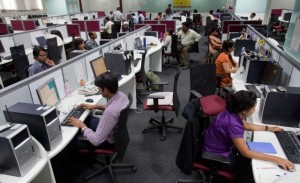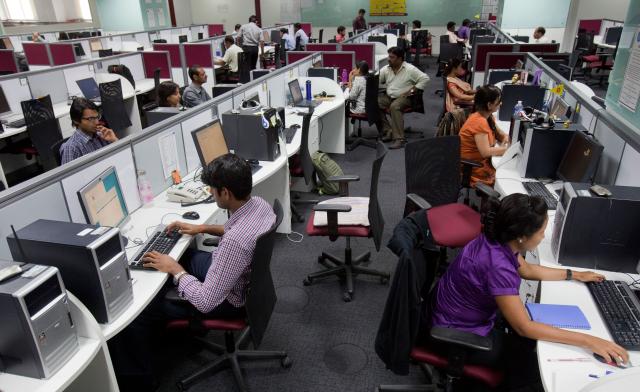News Point: As per Colliers Research gross office absorption grew by 23% YoY in Q3 to 12.3 mn sq ft; 26% for the first nine months to 36.4 mn sq ft. Average gross absorption of 46.0 mn sq ft to exceed average new supply of 41.2 million sq ft by 12% from 2018-2021.
 The gross leasing activity in India was recorded at 36.4 million sq ft for the first nine months of 2018, up 26% YoY. Pan-India demand for Grade A office space was driven by the technology sector (48%) in Q3 2018, followed by banking and insurance representing 19% of the total leasing volume.
The gross leasing activity in India was recorded at 36.4 million sq ft for the first nine months of 2018, up 26% YoY. Pan-India demand for Grade A office space was driven by the technology sector (48%) in Q3 2018, followed by banking and insurance representing 19% of the total leasing volume.
The need for workspace efficiency and a collaborative work environment has increased demand for flexible workspace, which accounted for 13% of pan-India office leasing volume in Q3 2018.
“Despite the currency fluctuations, the gross leasing activity in India across major 7 cities was recorded at 36.4 million sq feet for the first nine months of 2018, up 26% YoY. Bengaluru again saw the bulk (30%) of leasing activity during Q3 at 3.7 million sq feet followed by Hyderabad which replaced Mumbai to be the second most active market”, says Ritesh Sachdev, Senior Executive Director, Occupier Services at Colliers International India.
The leasing activity in Hyderabad doubled over Q2 to 2.1 million sq ft owing to large transactions by technology occupiers in the Secondary Business District (SBD) micro market.
“India’s GDP growth should reach about 7.5% for 2018 and stay strong for several years. Firm growth should fuel expansion in property and attract investment. For 2018-2021, we see average gross absorption of 46.0 million sq ft to exceed average new supply of 41.2 million sq ft by 12%. This should push up rents by 1.9% annually on average. Bengaluru should see the fastest growth, at 4.1%”, says Megha Maan, Senior Associate Director, Research at Colliers International India.
Flexible workspaces (co-working) has contributed close to 13% in the total YTD Q3 office leasing, reporting a 2x growth from last year YTD Q3 leasing. This trend indicates that 2019 will be an even more active year for the flexible workspace sector, fueled by an increase in end-user demand from the IT industry, looking for ways to mitigate real estate costs and seeking flexible solutions, Sachdev further added.
Bengaluru
Bengaluru recorded gross office absorption of 3.7 million sq ft in Q3 2018, representing a notable growth of 55% from the same period last year. Total Grade A office leasing through Q3 2018 was 11.4 million sq ft.
Further supporting the city’s real estate growth is the steady demand from the technology sector that constituted 41% of the total leasing activity in Q3 2018. This was followed by the Banking Financial Services and Insurance (BFSI) sector accounting for 27% of leasing activity, flexible workspace operators on 15%.
We expect factors including strong long-term economic growth, the availability of a deep talent pool, improvements in existing and upcoming infrastructure and a robust supply pipeline of 24.4 million sq ft over 2019-2021 to continue to drive demand for Grade A office space in Bengaluru.
We expect office leasing momentum to continue over 2019-2021 and reaffirm our average annual gross absorption of 14.5 million sq ft.
Hyderabad
Hyderabad recorded 2.13 million sq ft of gross office leasing in Q3 2018. YTD gross absorption is 3.60 million sq ft, which is similar to 2017 levels. Considering the large-scale expansion plans of IT-ITeS occupiers, we expect the demand outlook to remain firm towards the end of 2018 and the momentum is likely to continue over the next three years.
The IT-ITeS sector is likely to stay dominant over 2019-2021; investments by the government should boost demand from the pharmaceutical and biotechnology sectors.
In Q3 there was an increase in the number of deals by IT-ITeS occupiers, and the average deal size was 79,000 sq feet, higher than the annual average over the last two years of 45,000 sq feet.
Deals greater than 1,000,000 sq feet constituted 70% of total leasing activity in Q3 2018, which is 30% higher than Q2 2018, a likely indication of rising occupier confidence.
More than 36.4 million sq ft of Grade A office development under various stages of construction should increase the total office stock by 60% over 2018-21.
Mumbai
Mumbai recorded gross absorption of 1.9 million sq feet in Q3 2018, a QoQ increase of 11%. This take-up was concentrated in the Andheri East (25%), Navi Mumbai (18%), LBS/Eastern Suburbs (15%) and Goregaon/JVLR (12%) micro markets.
For the second consecutive quarter, flexible workspace operators drove leasing activity in Mumbai accounting for nearly 36% of gross absorption in Q3 2018, followed by BFSI occupiers representing 28% and consulting occupiers accounting for 15%.
Approximately 9.0 million sq ft of new supply is scheduled to appear during 2019-2021.
NOIDA
Leasing activity in NOIDA has gathered pace as tech occupiers and manufacturing companies lease space on the expressway. The market recorded gross absorption of 0.78 million sq ft in Q3 2018. Compared to the same period last year, leasing has increased by 30% as the average deal size expanded three times to 70,874 sq ft.
The NOIDA expressway micro market continued to dominate the leasing activity accounting for 61.2% of demand in Q3 2018. We expect this micromarket to remain the preferred destination amongst occupiers looking for consolidation and expansions across NOIDA due to the availability of Grade A office space and the good connectivity with Delhi. This dominance was primarily supported by technology-related occupiers, which concluded a few large deals in excess of 100,000 sq feet. The industrial sectors (57 to 60 and 63 to 65) and institutional sectors accounted for 32.1% and 6.7% of the leasing volume, respectively.
About 15.6 million sq ft of office developments is likely to be completed in a staggered manner in the next three years, increasing the total inventory by 53%.
Gurugram
Due to slower decision making on the part of occupiers, gross absorption declined 60% QoQ and 50% YoY. Q3 2018 noted leasing activity of 0.80 million sq ft with most occupiers expanding operations in the city. Contributing to the decline, deals in excess of 50,000 sq ft comprised 43% of leasing activity, compared to 69% in Q2 2018.
Considering the expansion plans of occupiers we expect demand to regain momentum in Q4 2018, and we expect the year 2018 to record 5.5 million sq ft of leasing activity.
We forecast a robust supply pipeline of 19.8 million sq ft until 2021 under various stage of construction.
Delhi
The office market recorded gross absorption of 0.14 million sq ft in Q3 2018, representing a quarterly contraction of 6.7%. Over the last three quarters, the continued decline in demand can be attributed to a lack of Grade A space in major micromarkets such as the CBD and Aerocity, as evidenced by the CBD recording a significant decline in take up compared to last quarter.
About 4.8 million sq ft of office space is expected to be completed during 2018 – 2021, the majority of which is in South Delhi.
Pune
Pune witnessed gross absorption of 1.8 million sq ft in Q3 2018, more than double the absorption in Q2 2018. The leasing activity is driven by absorption of pre-committed spaces by technology occupiers and flexible workspace operators. Despite significant new supply, rental values appreciated 3-6% QoQ in select micro markets including Nagar Road, Baner and Kharadi.
About 13 million sq ft of new supply, an increase of 29% citywide, is due to appear in 2019-2021. However, a portion of the new supply may be deferred.
Chennai
The third quarter saw leasing of about 760,000 sq ft leading to YTD 2018 absorption of 2.80 million sq ft. The YTD gross absorption declined 13% in comparison to the same period in 2017.
Though the average deal size has increased in Q3, the fall in number of transactions has brought down the leasing volume. However, we expect the number of deals to increase in Q4 owing to steady enquiries by occupier and the year is expected to close at levels similar to 2017.
About 17 million sq ft likely to be added to the inventory over 2018- 2021, increasing the total office stock by 30%.
Kolkata
Kolkata recorded gross absorption of 0.30 million sq ft in Q3 2018 representing a QoQ increase of about 50%. In Q3 2018, Grade A space take-up was concentrated in the Peripheral Business District (PBD) and Sector V, accounting for 43% and 38% of the total absorption respectively. Leasing activity in Information Technology developments accounted for 37% of the total absorption in Q3 2018.
Colliers expects total new supply of 3.1 million sq ft to get completed between Q4 2018 and 2021.





